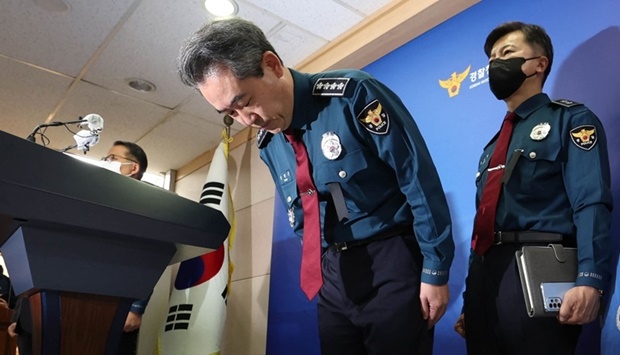South Korean police admitted Tuesday their emergency response to a deadly Halloween crush had been "insufficient", with top officials saying crowd management failures had likely contributed to the disaster.
At least 156 mostly young people were killed, and scores more injured, in a deadly crowd surge late Saturday at the first post-pandemic Halloween party in Seoul's popular Itaewon nightlife district.
An estimated 100,000 people had flocked to the area, but because it was not an "official" event with a designated organiser, neither the police nor local authorities were actively managing the crowd.
"There were multiple reports to the police indicating the seriousness at the site just before the accident occurred," national police chief Yoon Hee-keun said.
Police knew "a large crowd had gathered even before the accident occurred, urgently indicating the danger," he said, acknowledging the way this information was handled had been "insufficient".
Transcripts of emergency calls reported by South Korean news agency News1 documented how desperate members of the public had flagged dangerous overcrowding hours before disaster struck at around 10:00 pm local time (1300 GMT) Saturday.
At 8:09 pm one caller told police: "There are too many people here being pushed, trampled, hurt. It's chaotic. You need to control this."
Seoul's interior minister, who had been criticised for earlier comments in which he claimed deploying more police would not have prevented the crush, apologised Tuesday for the disaster.
Lee Sang-min expressed his "sincere apologies to the public as the minister in charge of the people's safety for this accident", before bowing his head before lawmakers and cameras.
He promised to investigate what had caused the crowd crush and to ensure a disaster of this scale could never happen again.
Seoul Mayor Oh Se-hoon also made a public apology, weeping as he said he felt "infinitely responsible for this accident".
Prime Minister Han Duck-soo said Tuesday that a lack of a proper crowd management system may have caused the incident, adding that a full review was ongoing.
South Korea is typically strong on crowd control, with protest rallies often so heavily policed that officers can outnumber participants.
But police deployed only 137 officers to Itaewon for Halloween, while 6,500 officers were present at a protest across town attended by about 25,000 people, local reports said.
South Korean President Yoon Suk-yeol said Tuesday the country needed to urgently improve its system for managing large crowds in the wake of the disaster.
"The safety of the people is important, whether or not there is an event organiser," he told a cabinet meeting.
He called for the country to develop "cutting-edge digital capabilities" to improve crowd management -- but critics claim such tools already exist and were not deployed in Itaewon.
Seoul's City Hall has a real-time monitoring system that uses mobile phone data to predict crowd size, but it was not employed Saturday night, local media reported.
Itaewon's district authorities also did not deploy any safety patrols, with officials saying the Halloween event was considered "a phenomenon" rather than "a festival", which would have required an official plan for crowd control.
On the night, tens of thousands of people thronged a narrow alleyway, with eyewitnesses describing how, with no police or crowd control in sight, confused partygoers pushed and shoved, crushing those trapped in the lane.
Crowd management experts told AFP that the disaster was easily avoidable, even with only a small number of police officers.
"Good, safe crowd management is not about the ratio, but about the crowd strategy -- for safe crowd capacity, flow, density," said G. Keith Still, a crowd science professor at the University of Suffolk.
South Korean expert Lee Young-ju said that if local police knew they would be short-handed, they could have sought help from local authorities or even residents or shop owners.
"It's not just the numbers," Lee, a professor from the Department of Fire and Disaster at the University of Seoul, told AFP.
"The question is, how did they manage with the limited number (of police) and what kind of measures did they take to make up for it."

